The A6 Years Part II
'A' for Alfieri and '6' for the number of cylinders.
"... built for road and race, Sports Car and Formula 2".
It was the rivalry with
Ferrari which stirred Maserati from its dormant years in the early fifties. Maserati had now left
the factory to form OSCA and the Orsi family decided to meet the challenge on all fronts: F1,
F2 and 'sports car', with less emphasis on 'gran turismo' production. In 1951, the talents of Alberto
Massimino, now promoted technical director in place of Ernesto Maserati, focussed on
plans for a new F2. This was now the senior formula as race organisers had decided that their
round on the World Championship would be held to Formula 2 regulations. This caused the abandonment of
the F1 World Driver's Championship in 1952 and 1953. It seemed obvious to Maserati to start with
the basic A6GCS, considering its occasional use for 'sports car', with minor modifications for formula
'Cadet'. And so was born the 'A6GCM' (M for 'monoposto' - single-seater). But alas once again
this hybrid achieved little success on the track.
The man who changed their
fortunes was Gioacchino Colombo, father of the Grand Prix 'Alfette' and designer of the
first 12-cyl Ferrari. Colombo, who replaced Massimino in the months prior to his leaving Maserati
to join Bugatti, modernised Maserati's technical department, thereby laying the foundations
for the successes of the Fifties and the Sixties.
The first Maserati on
which Colombo concentrated his efforts was the 'A6GCM'. The stroke of the 6-cyl engine was
shortened to gain more revs; increasing power to a respectable 190bhp. With a little work
on the suspension and brakes, Maserati had a winning 'monoposto' by the end of 1952. Colombo's
revised 'A6GCM' was an instant success, demonstrating itself to be the only car capable of
challenging the dominance of the Ferrari '500 F.2'. But above all it was the inspiration for the
'A6GCS/53', the car that replaced the now ageing 'A6GCS'. The main changes made were to
the engine: the cylinder size, the induction system, the gear-driven twin overhead camshafts and
the twin ignition system. The engine of the 'A6GCS' was very similar to that of the 'A6GCM' and had
a power output of 170bhp, with only one major difference: the adaptation for the use of commercial
petrol, in anticipation of a change in motor sport regulations.
The A6GCM
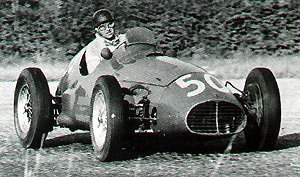
Juan Miguel fangio winning the Italian GP at Monza in the Formula 2 Maserati A6GCM.
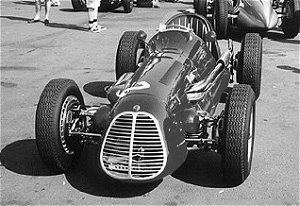
A 1951 A6GCM Formula 2.
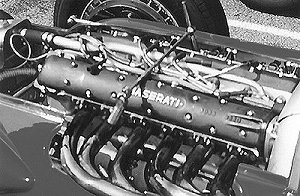
The A6GCM Formula 2 DOHC engine.
| A6GCM Technical specification |
| Engine |
Front engined 6-cylinder in line |
| Bore and stroke |
72.6mm x 80mm (1951-52) - 75mm x 75mm (1952) - 76.2mm x 72mm (1953) |
| Cubic capacity |
1987 cc (1951-52) - 1988.1 cc (1952) - 1959.5 cc (1953) |
| Compression ratio |
13.5:1 (1951-52) - 12:1 (1953) |
| Distribution |
DOHC with 2 valves per cylinder |
| Induction system |
Normally aspirated with No 3 Weber
38DCO3 (40DCO3) carburettors |
| Power output |
160bhp @ 6500 rpm (1951-52) - 180bhp @ 7300 rpm (1952)
197bhp @ 8000 rpm (1953) |
| Ignition |
Single with Marelli ST25DAS magneto(1951-52)
Double with Marelli ST25DAS magnetos(1952-53) |
| Lubrication |
Forced by pressure and scavenger pumps |
| Cooling |
Water cooled forced by centrifugal pump |
| Gearbox and clutch |
4-speed and reverse - dry multiplate
plate |
| Transmission |
Rear wheel drive |
| Chassis |
Tubular structure with longitudinal and cross
members |
| Front suspension |
Independent with coil springs and
Houdaille hydraulic shock absorbers |
| Rear suspension |
Rigid axle with longitudinal leaf springs
and
Houdaille hydraulic shock absorbers |
| Steering |
Rack and pinion |
| Brakes |
Hydraulically operated drum brakes |
| Wheels |
Wire wheels 4.00 x 15 (1951-52) - 5.00 x 16 (1953) |
| Tyres |
Pirelli front 5.00 x 15 / 5.50 x 15 (1951-52) - 5.25 x 16 (1953)
and rear 6.00 x 15 / 6.50 x 15 (1951-52) - 6.50 x 16 (1953) |
| Wheelbase |
2280mm (1951-52) - 2310mm (1953) |
| Wheel track |
Front - 1278mm (1951-52) - 1225mm (1953)
Rear -
1200mm (1951-52) - 1160mm (1953) |
| Dry weight |
550 - 560 kg (1951-52) - 570 kg (1953) |
| Bodywork |
Single-seater in aluminium (probably by Medardo Fantuzzi) |
| Maximum speed |
250 kph / 156 mph |
Following his usual approach,
Colombo, having worked on the engine, set about improving the performance of the 'A6GCS'
by scrutinising every other component. For the body he opted for the 'Barchetta' shape, which
offered aerodynamic advantages. The body remained largely unchanged during its entire production;
the only difference was to the front grille which was eventually adorned with the Trident.
Colombo was quite happy to retain the better characteristics of the 'GCS' and transferred to the
'GCS/53' all the experiences he had gained in the designing of the 'GCM'.
He made alterations to the suspension geometry and finally improved brake cooling.
The setting up of a World
Championship for sports cars in 1953 gave the 'A6GCS/53' project a tremendous boost. From its
first appearances, its debut was at the Tour of Sicily 1953, the 'A6GCS/53' revealed
extraordinary speed and handling qualities. On circuits around the world they were often to be
seen leading opposition powered by engines of a greater capacity.
Many drivers achieved success, nationally and internationally, in the 'A6GCS/53' and of these two in particular stood out, Sergio Mantovani and Luigi Musso who in 2-litre Maseratis
won Italian Championships in 1953 and 1954, before moving on to Formula 1. Other drivers and owner/drivers who cannot
go unmentioned are Emmanuel De Graffenried, Emilio Giletti, Felice Bonetto, Alfonso De Portago,
Cesare Perdisa, Benoit Musy and Maria Teresa De Filippis (now President of the Registro Maserati).
All the 'A6GCS/53s' were
fitted with bodies by Medardo Fantuzzi and in some cases by Celestino Fiandri. The only
exceptions being three Berlinettas with coachwork by Pinin Farina and two spiders, one by
Frua and the other by Vignale. In two years (from May 1953 to April 1955), total production was
52 cars. An exceptional number for that period when one realises that this was primarily a competition model.
The A6GCS/53
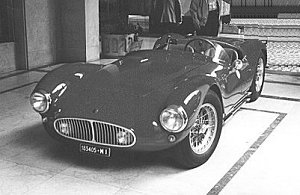
The A6GCS/53 Barchetta with coachwork by Medardo Fantuzzi.
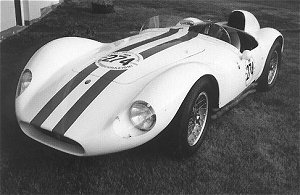
The A6GCS/53 Barchetta with coachwork by Medardo Fantuzzi.
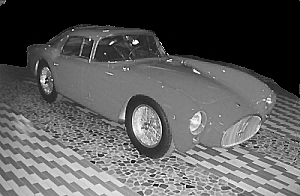
The A6GCS/53 Berlinetta with coachwork by Pinin Farina.
| A6GCS/53 Technical specification |
| Engine |
Front engined 6-cylinder in line |
| Bore and stroke |
76.5mm x 72mm |
| Cubic capacity |
1985.6 cc |
| Compression ratio |
8.75:1 |
| Distribution |
DOHC with 2 valves per cylinder |
| Induction system |
Normally aspirated with No 3 Weber
40DCO3 carburettors |
| Power output |
170bhp @ 7300 rpm |
| Ignition |
Double with Marelli ST65DTEM distributors(1952-53) |
| Lubrication |
Forced by pressure and scavenger pumps |
| Cooling |
Water cooled forced by centrifugal pump and oil cooler |
| Gearbox and clutch |
4-speed and reverse - dry multiplate
plate |
| Transmission |
Rear wheel drive |
| Chassis |
Tubular structure with longitudinal and cross
members |
| Front suspension |
Independent with coil springs and
Houdaille hydraulic shock absorbers and anti-roll bar |
| Rear suspension |
Rigid axle with longitudinal leaf springs
and
Houdaille hydraulic shock absorbers and anti-roll bar |
| Steering |
Rack and pinion |
| Brakes |
Hydraulically operated drum brakes
(diameter front 328x60 mm and rear 290x50 mm) |
| Wheels |
Wire wheels 4.50 x 16 |
| Tyres |
Pirelli front 6.00 x 16 |
| Wheelbase |
2310mm |
| Wheel track |
Front - 1335mm / Rear - 1220mm |
| Dry weight |
740 kg |
| Bodywork |
Two-seater barchetta, berlinetta and spider |
| Overall dimensions |
Length - 3840 mm / Width -
1530 mm / Height - 860 mm |
| Maximum speed |
235 kph / 147 mph |
In 1954, following the
success of the ‘A6GCS/53’, Maserati produced a Touring version, the 'A6G/54'.
Presented at the Paris Motor Show, it was fitted with the 6 cylinders 2-litre twin overhead
camshaft engine of the 'sports car' but this time no effort was made to detune the engine. This did not escape the notice of
certain customers who raced them in the GT category. Sixty units of the 'A6G/54' were produced
with coachwork by Frua, AIlemano and as shown below by Zagato.
The A6G/54
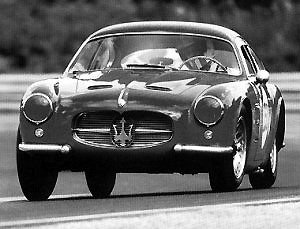
The last of the road A6s, the A6G/54 with coachwork by Zagato.
| A6G/54 Technical specification |
| Engine |
Front engined 6-cylinder in line |
| Bore and stroke |
76.5mm x 72mm |
| Cubic capacity |
1985.6 cc |
| Compression ratio |
8:1 |
| Distribution |
DOHC with 2 valves per cylinder |
| Induction system |
Normally aspirated with No 3 Weber
40DCO3 carburettors |
| Power output |
150bhp @ 6000 rpm |
| Ignition |
Double with Marelli ST111DTEM distributors(1952-53) |
| Lubrication |
Forced by pressure pump |
| Cooling |
Water cooled forced by centrifugal pump and oil cooler |
| Gearbox and clutch |
4-speed and reverse - single dry plate
plate |
| Transmission |
Rear wheel drive |
| Chassis |
Tubular structure with longitudinal and cross
members |
| Front suspension |
Independent with coil springs and
Houdaille hydraulic shock absorbers and anti-roll bar |
| Rear suspension |
Rigid axle with longitudinal leaf springs
and
Houdaille hydraulic shock absorbers and anti-roll bar |
| Steering |
Rack and pinion |
| Brakes |
Hydraulically operated drum brakes
(diameter front 328x60 mm and rear 290x50 mm) |
| Wheels |
Wire wheels 4.50 x 16 |
| Tyres |
Pirelli front 6.00 x 16 |
| Wheelbase |
2550mm |
| Wheel track |
Front - 1360mm / Rear - 1220mm |
| Dry weight |
840 kg |
| Bodywork |
Two-seater barchetta, berlinetta and spider |
| Overall dimensions |
Length - 3840 mm / Width -
1530 mm / Height - 860 mm |
| Maximum speed |
195 - 210 kph / 147 mph |
When at the end of 1953
the international motor racing body raised the permitted engine capacity to a maximum of 2500 cc,
the remaining 2-litres cars, single-seater and 'sports car', were officially withdrawn, but many
continued to race under private ownership for some years. 1954 saw the arrival of the 250F (F for Formula 1) and the 250S (S for sports car), but that's another story.
|
|
|
|
|
|
|
To enter Enrico's Maserati Pages CLICK HERE!
Copyright: Enrico's Maserati Pages - © 2000-2005. All rights reserved. |





